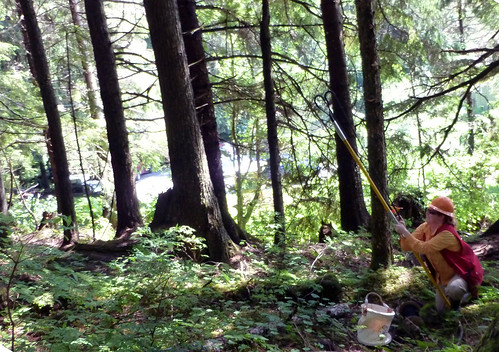
Alex Vaisvil, a student intern from Xavier University in Cincinnati, Ohio, lowers a Lindgren multi-funnel trap to lure longhorned beetles from the mid-canopy in the Tongass National Forest. Traps were located in the forest as part of a study to refine woodborer trapping methods in Southeast Alaska. (U.S. Forest Service/Elizabeth Graham)
Non-native longhorned beetles are easily transported around the world in solid wood packing material, arriving in a new location with no natural enemies to control their populations. Across the country, many of these non-native beetles, particularly the Asian longhorned beetle, have killed tens of thousands of hardwood trees, especially in eastern states.
Will these pests ravage trees in Southeast Alaska? U.S. Forest Service specialists are working to determine ways to prevent the kind of devastation they’ve had elsewhere.
“Alaska has been lucky compared to the rest of the country when it comes to invasive woodborers, such as the emerald ash borer and the Asian longhorned beetle,” said Elizabeth E. Graham, an entomologist for the agency’s Alaska Region. “However if an invasive species established itself in our Alaskan forests, which are dominated by very few tree species, the effect would be devastating and extremely difficult to manage. We’ve only seen success in stopping the spread of invasive species in areas where they were detected early and swift action was taken.”
Research on pheromones of longhorned beetles shows they can be effectively used to monitor and survey beetles but they have not been tested in the wet environment of Southeast Alaska, according to Ann Ray, an assistant biology professor at Xavier University in Cincinnati, Ohio, and a research collaborator. To determine the best trap/pheromone emitter for Southeast Alaska, the university and the Forest Service are studying the efficacy of different types of pheromone emitters and different trap designs and their height placement on trees.
“The most effective traps for wood- boring beetles are designed to mimic the silhouette of a tree,” Ray said. “We bait the traps with an attractive component, such as pheromones, which are chemicals the insects use to communicate with other members of their species. They lure the beetles to the trap and the beetles are collected in the container below.”
Three different trap types were compared: Lindgren multi-funnel traps, panel intercept traps, and clear panel intercept traps. The traps were used in Juneau, Alaska, at two sites on the Tongass National Forest and a third site at the Jensen-Olsen Arboretum, a public garden north of Juneau. Traps were placed at the understory and canopy level to compare the effect of trap height on beetle collections.
Typically, a healthy tree has defense mechanisms to protect itself from beetle attack, such as sap or resin that oozes out and smothers the beetle. Longhorned beetles prefer to attack weakened and dying trees that are incapable of defending themselves. Those trees serve as a host for young beetles.
In a way, the beetles begin the decomposition process and aid in forest succession. But under the right circumstances, longhorned beetles can become a major forest pest. An abundance of stressed trees, such as following a disturbance and/or under certain climate conditions, can provide enough breeding material for beetle populations to reach outbreak level. At that point, healthy trees may be attacked as well. However, the most threatening insects to a healthy forest are non-native species, like the Asian longhorned beetle, that can be introduced into a new area.
“We check the traps regularly and identify the species of beetles,” said Graham. “So far, we’ve collected no non-native species. However, our study results will be helpful in determining the best method for detecting non-native beetles and monitoring native populations of longhorned beetles in a coastal rainforest.”

Elizabeth Graham, an entomologist with the Alaska Region’s Forest Health Protection staff, shoots a rope into a tree on the Tongass National Forest. The rope is used to raise woodborer traps into the forest canopy. (U.S. Forest Service/Kat Pratt)
No comments:
Post a Comment
Note: Only a member of this blog may post a comment.